UPDATE, 3/20/24: In March, the Guttmacher Institute published actual abortion pill totals for 2023, which were slightly higher than what was estimated here. Those updated numbers can be seen at Live Action News here.
3/8/24: Abortion pill-related emergency room visits are estimated to be in the tens of thousands, based on published percentages for ER visits on the drug’s 2023 label. The label, according to plaintiffs in an abortion pill lawsuit soon to be heard by the U.S. Supreme Court, also allegedly shows that “roughly one in 25 women who take mifepristone will end up in the emergency room.”
In addition, according to the drug’s medication guide, it is estimated that in 2023, between 11,000 and 39,000 women who took the abortion pill potentially needed “a surgical procedure because the pregnancy did not completely pass from the uterus or to stop bleeding.“
Currently there are no federal requirements that abortion pill complications or ‘adverse events’ must be reported, other than known abortion pill-related deaths.
‘One in 25’ Abortion Pill Clients Could End Up in ER
In its brief, filed in the Alliance for Hippocratic Medicine (AHM) v. Food and Drug Administration (FDA) case being heard before the United States Supreme Court this month, AHM wrote, “FDA has long recognized that emergency care is essential to handle abortion-drug complications; the agency’s own numbers say that roughly one in 25 women who take mifepristone will end up in the emergency room; and Respondent doctors have testified to routinely treating women suffering abortion drug harm,” the AHM brief claimed.
“Factor in that hundreds of thousands of women take abortion drugs each year in the United States, and that FDA’s own data indicates that tens of thousands of them go to the emergency room, and Respondents easily establish a ‘substantial risk’ that these harms ‘will occur’ again.”
To justify that statistic, AHM pointed out how the FDA’s own 2023 mifepristone label in table 2 (Serious Adverse Reactions Reported in Women Following Administration of Mifepristone [oral] and Misoprostol [buccal] in U.S. and Non-U.S. Clinical Studies) acknowledges that “2.9 to 4.6 percent of women who take abortion drugs end up in the emergency room.”
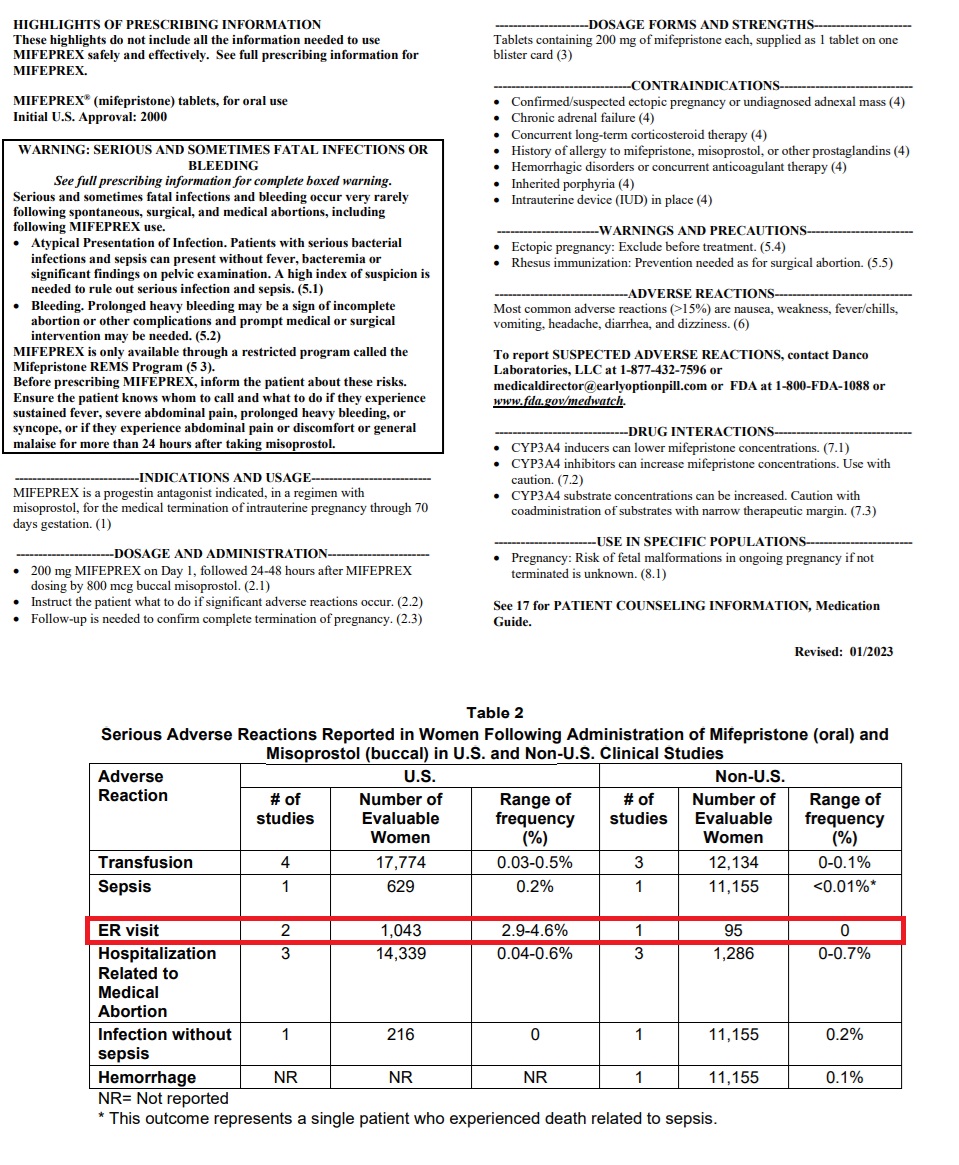
Mifepristone Jan 2023 label shows percentage of women taking abortion pill visit ER
The data also is similar to findings from a previously documented Gynuity Health Projects (GHP) telabortion study which found that six percent (6%) of participants (70 out of 1,157) faced complications from the abortion pill which resulted in ER visits or urgent care visits. Gynuity is a pro-abortion group, conducting clinical trials on the abortion pill and funded by organizations with deep historic ties to the American eugenics movement.
Black Box Warning and Medication Guide
“FDA’s current label for mifepristone continues to require a Black Box warning because the drug can cause ‘[s]erious and sometimes fatal infections and bleeding’… It also directs women to emergency rooms if one of many adverse complications arise,” AHM wrote in the brief.
The doctors added:
On that label, FDA estimates that 2.9 to 4.6 percent of women will visit the emergency room after taking mifepristone… And FDA’s medication guide acknowledges that as many as 7 percent of women will need surgery after taking mifepristone ‘to stop bleeding’ or to complete the abortion…
The label also warns that a prescriber must ‘[e]xclude [ectopic pregnancy] before treatment,’…’because some of the expected symptoms experienced with a medical abortion (abdominal pain, uterine bleeding) may be similar to those of a ruptured ectopic pregnancy.’
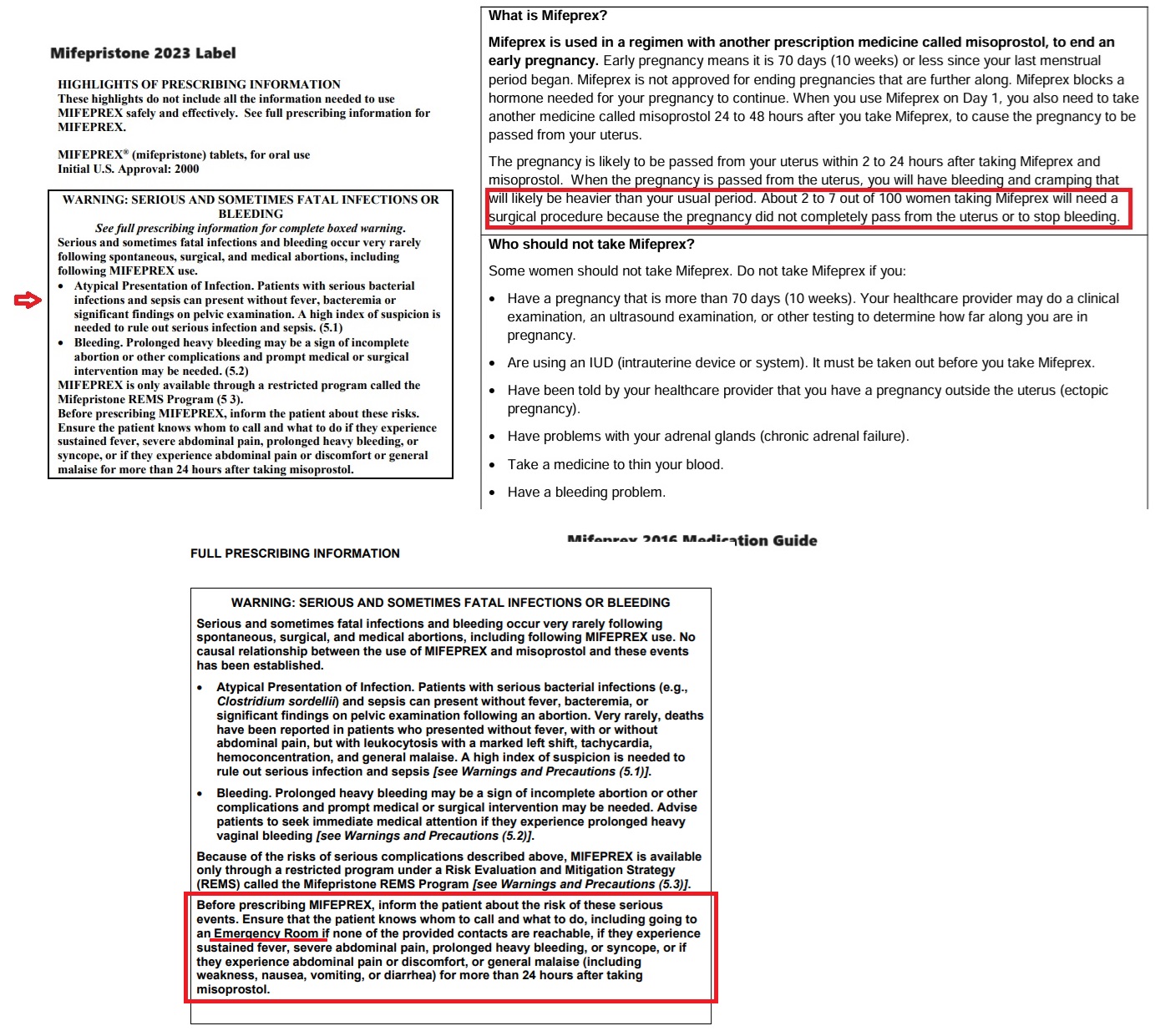
Abortion pill Black Box warning and medication guide suggests sending women to ER
This number was reiterated in a separate amicus brief filed by the Family Research Council and Martha Shuping, M.D., which stated in part, “The current mifepristone label states that 2.9–4.6% of women will require an emergency room visit. This mirrors another established source. According to a health education page on the University of California San Francisco (UCSF) website, ‘[a]bout 3 to 5% of patients need an additional aspiration procedure due to ongoing pregnancy, prolonged or excessive bleeding, or preference.’”
Tens of Thousands of Abortion Pill Clients Potentially Present to ER
Abortions by pill now make up the majority of all abortions committed in the United States — 53% in 2020 alone, according to Planned Parenthood’s former “research affiliate” the Guttmacher Institute.
2020:
- In 2020, before Roe was overturned, Guttmacher recorded 930,160 abortions committed nationally, and its report noted, “There were 492,210 medication abortions in 2020, a 45% increase from 2017.”
- Therefore, if we utilize the 2.9% to 4.6% emergency room visit percentage range from FDA’s label for mifepristone, we estimate 14,274 to 22,642 women who potentially sought help from an emergency department in 2020.
- In addition, using the 2-7% figure off the medication guide, we estimate that 9,800 to over 34,000 women taking the abortion pill potentially required “a surgical procedure because the pregnancy did not completely pass from the uterus or to stop bleeding.”
2023:
A review of Guttmacher’s estimated data, published at its Monthly Abortion Provision Study website, revealed that between January 2023 and October of 2023, nearly 900,000 (878,000) abortions were estimated to have been committed. In addition, an average of 88,000 abortions were estimated to have occurred each month, a figure confirmed by #WeCount estimates recently published by the pro-abortion Society of Family Planning (SFP). According to Dr. Michael New, these estimates found that “between July 2023 and September 2023 approximately 81,000 to 89,000 abortions were performed every month.”
Extrapolating this data for the remaining portion of the year reveals that 2023 abortions are likely to reach over one million (1,054,000) — the highest recorded since 2011.
- Multiplying 53% of the 2023 estimated abortions (1,054,000), we estimate that 558,620 abortions were likely committed by the abortion pill in 2023.
- Then, if we utilize the 2.9% to 4.6% emergency room visit percentage range from FDA’s label for mifepristone, we estimate 16,200 (2.9%) to 25,700 (4.6%) women potentially sought assistance from an emergency department in 2023 after taking the abortion pill.
- In addition, using the 2-7% figure off the medication guide, we estimate that between over 11K-39K of women taking the abortion pill potentially required “a surgical procedure because the pregnancy did not completely pass from the uterus or to stop bleeding.”
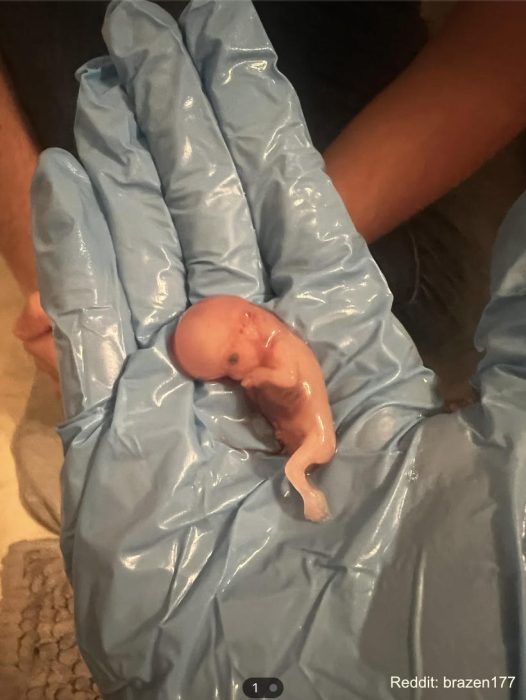
Photo: Reddit user brazen 177 (10-week aborted baby by abortion pill)
Tragically, after actual abortion pill numbers were published by the Guttmacher Institute, Live Action News discovered that potential emergency room visits from abortion pill related complications in 2023 were higher than what Live Action News had estimated above.
- Estimating ER visits from the newly published abortion pill data for 2023 reveals that out of the 642,700 abortion pills recorded by Guttmacher, between 19,000 (18,638) and 30,000 (29,564) women who took abortion drugs may have potentially ended up in the emergency room in 2023.
- In addition, using the 2-7% figure from the medication guide, we estimate that between 13,000 and 45,000 women who took the abortion pill in 2023 potentially required “a surgical procedure because the pregnancy did not completely pass from the uterus or to stop bleeding.”
Hiding Abortion Pill Complications
While anyone can still file an adverse event report with the FDA, there are no requirements that this should happen. In 2016, the Obama administration’s FDA weakened the REMS safety requirements for the abortion pill by removing the in-person requirement for taking the drug and removing the requirements that the manufacturer report the drug’s non-fatal adverse events (complications).
To further cloud the data, abortion insiders have suggested that women should lie and claim to be miscarrying naturally when they present to the emergency room with abortion pill complications. This dampens any chance that accurate numbers on abortion pill complications or deaths will be reported as such to authorities.
And, to make matters worse, even the FDA appears to be moving in lock step with this idea by eliminating specific text (see images below) from the black box warning and the patient counseling section of the abortion pill’s January 2023 label.
The text, according to the FDA’s 2019 Mifepristone label (as well as older labels), previously stated, “Advise the patient to take the Medication Guide with her if she visits an emergency room or a healthcare provider who did not prescribe MIFEPREX, so that the provider knows that she is undergoing a medical abortion (emphasis added).”
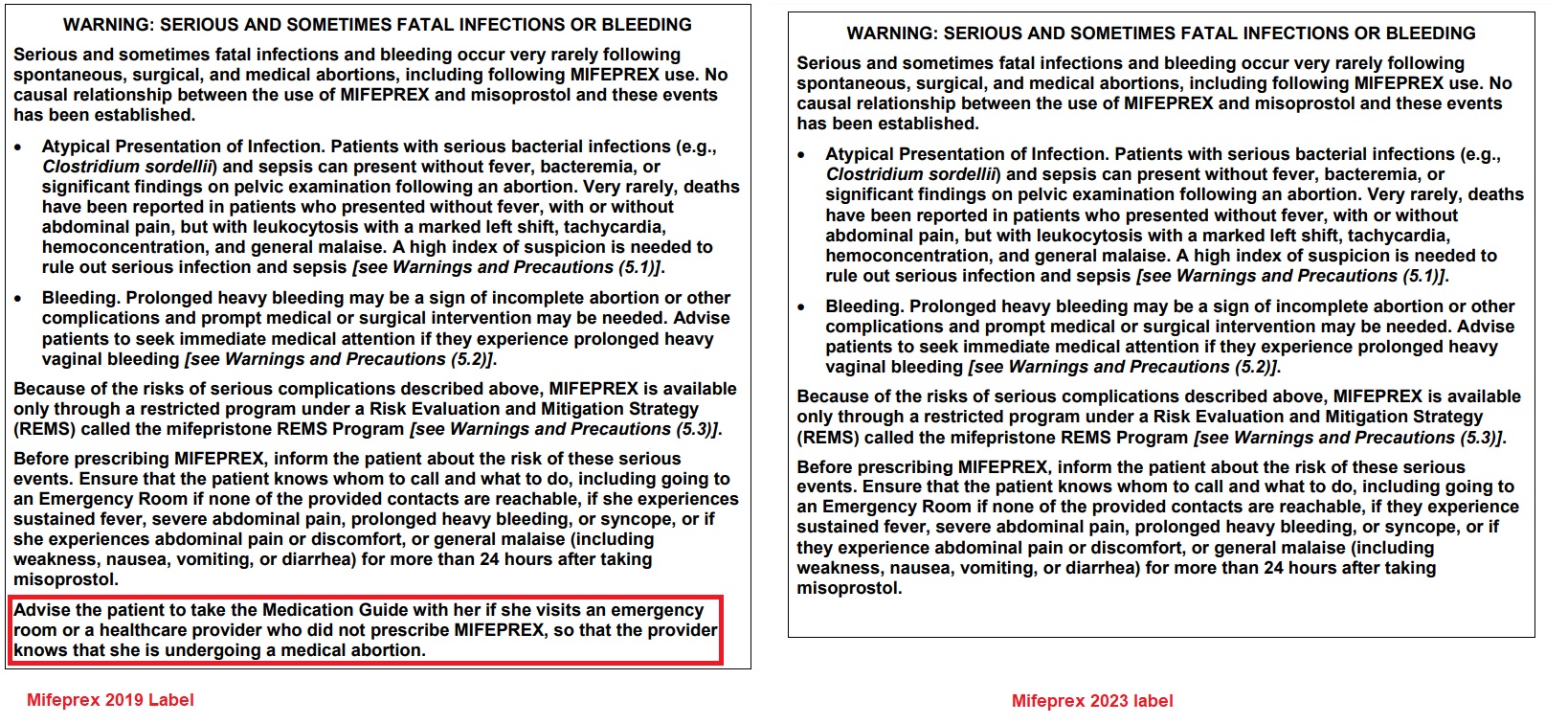
Abortion pill label changes (2019 to 2023) edits to Black Box Warning and counseling section
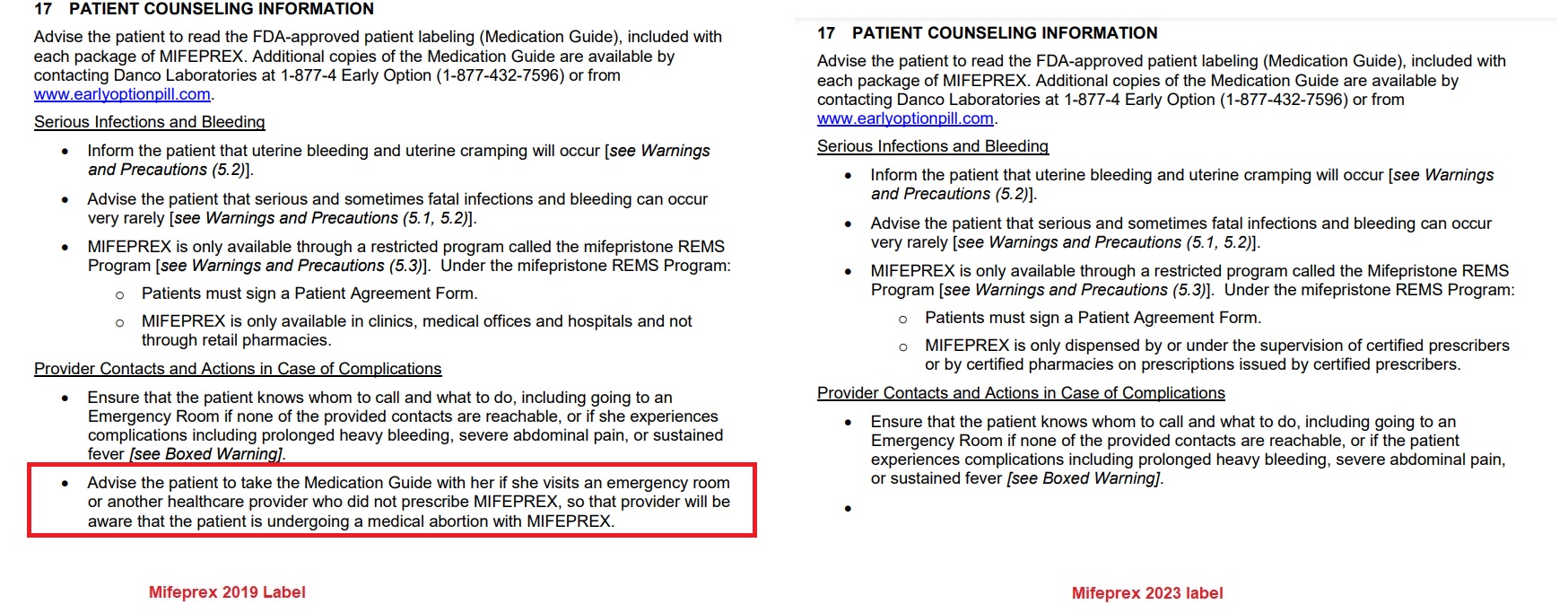
Abortion Pill Label Changes 2023 no longer tells women to bring medication guide to ER
Today, the profitable abortion industry touts abortion drugs as safe and simple despite multiple conflicts of interest surrounding the studies, their authors, and even the testing sites and sponsors.
In addition, bad actors inside the abortion industry continue to flout the FDA’s REMS by ignoring the approved gestational limits or approved protocols for prescribing the abortion pill; leaving women to deal with ectopic pregnancies by not ruling them out prior to prescribing the drug; promoting an unapproved one-drug regimen of misoprostol only; dispensing abortion drugs to women who are not yet pregnant; and encouraging women to present to the emergency room and claim a natural miscarriage when experiencing abortion pill related complications.
Editor’s Note, 3/20/24: This article was updated with additional information based on statistics released after original publication.







